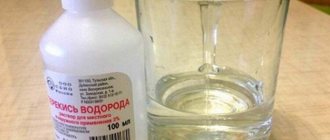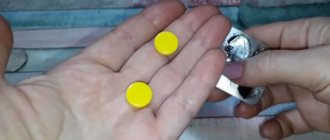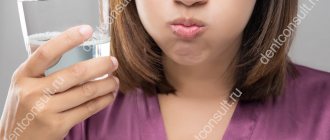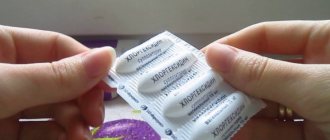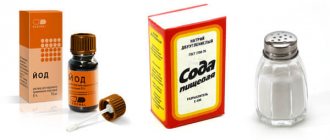01/18/2022
134 196
11 minutes
Co-author, editor and medical expert – Maksimov Alexander Alekseevich.
Hydrogen peroxide was discovered in 1818 by L.Zh.Thenar. Chemical designation H2O2. The substance itself is an almost colorless (pale blue) viscous substance. Hydrogen peroxide without impurities is an unstable substance; it has the ability to decompose to water and oxygen, releasing a large amount of heat. Unlimitedly soluble in water, alcohols and ethers. There is a 31% solution on sale called “Perhydrol”. Due to its oxidizing properties, hydrogen peroxide acts as an antiseptic. For medical use, a 3% H2O22 solution is used.
When peroxide gets on biological substrates (damaged mucous membranes, microbes), active oxygen is released, which destroys cell membranes, thereby providing an antiseptic effect and cleansing the oropharyngeal mucosa from pathogens and cellular detritus. It also has hemostatic properties1.
Up to contents
Is it possible to gargle with peroxide?
Only a doctor can correctly diagnose and prescribe treatment. To effectively get rid of tonsillitis, consult a specialist.
According to the instructions for use, peroxide is used as a treatment for the pharynx in acute tonsillitis, gingivitis, stomatitis and other pathologies. For treating mucous membranes, a 0.25% solution of hydrogen peroxide is acceptable1. When rinsing, microbial contamination in the throat decreases and inflammation decreases. Lubricating the mucous membrane of the tonsils with a cotton swab dipped in a solution is also used, which helps to avoid unwanted effects on the rest of the epithelium. On the other hand, peroxide does not act selectively on tissues, that is, it damages, along with bacteria, unchanged tissues of the body, which can delay recovery. With long-term treatment with peroxide, adverse reactions are possible: burns of the mucous membrane; in case of allergic reactions, bronchospasm and laryngospasm may develop; if accidentally swallowed, it has a toxic effect on the gastrointestinal tract; if it enters the bloodstream, it causes hemolysis of red blood cells. As science moves forward, this method of treatment fades into the background. Safer and more effective drugs are appearing.
Up to contents
Is it possible to rinse
A problem that often faces patients is whether it is acceptable to use peroxide for rinsing and disinfecting inflamed mucous membranes of the mouth and throat?
According to the annotation, the drug is widely used in relation to festering wounds, inflammatory processes on the mucous membranes and soft tissues of the body, relieves swelling and eliminates pain. Rinse effect:
- Reduces purulent contents of the throat
- Swelling decreases
- Reduces pain in inflamed areas
Before deciding to use a peroxide solution as a means of fighting infection, you must read the instructions for the drug.
Indications
Hydrogen peroxide is widely used in medicine: in surgery for the treatment of purulent wounds, for inflammatory diseases of the mucous membranes, pharyngitis, periodontal disease, for bleeding, for disinfecting instruments and deodorizing. Gargling with hydrogen peroxide makes sense when treating bacterial sore throat. But treatment with only one remedy will not be effective. It should be noted that gargling is an integral part of the complex therapy of tonsillitis.
How to treat a throat with gargling? Let's take a closer look at this issue.
| Recipe for a solution with peroxide You should not prepare the solution for future use; it is better to prepare a fresh one each time, since hydrogen peroxide erodes in the air and there will be no effect from such treatment. | To prepare the desired product, we need 1 part 3% hydrogen peroxide and 11 parts water. Water should be used boiled, cooled to a comfortable temperature of 36-37 degrees. |
| Application of the solution If you tilt your head back, the back wall of the pharynx and tonsils, and the root of the tongue will be more effectively cleansed. Remember that you should not swallow peroxide. | 1. Before the procedure, you should clear your mouth of any remaining food. 2. Take a sip, gargle for 10 seconds and spit. The steps are repeated until the solution runs out. 3. At the end of the procedure, be sure to clear the oropharynx of traces of the product with calendula tincture, chamomile tea or plain water. 4. For the next thirty minutes, you should refrain from eating and drinking. |
The duration of sessions is determined by the severity of the condition. Usually it is 4-5 days, with a frequency of 3-4 times a day. Due to oxidation, including healthy tissue, the use of peroxide can lead to increased sore throat and cough.
In addition to it, there are currently other drugs that are superior in their effectiveness. For example, Hexoral ® rinse solution. The drug is widely active against various types of bacteria and fungi of the genus Candida, and Hexoral ® also treats infections caused by Pseudomonas aeruginosa and Proteus. At a concentration of 100 mg/ml, the drug inhibits the growth of most bacterial strains. In addition, the active substance hexethidine has a weak analgesic effect. Hexoral ® solution is convenient and easy to use and has a pleasant taste. It does not need to be diluted. For adults and children over 3 years old, it is enough to gargle with 15 ml of solution 2 times a day3.
Up to contents
For what dental problems is the product used?
If we talk about treatment (application to the surface of enamel and soft tissues, applications, rinsing) and rinsing the mouth with hydrogen peroxide, then this procedure is considered appropriate as part of a set of measures for the following problems:
Pigmentation of teeth is one of the possible reasons for using hydrogen peroxide
- increased accumulation of soft plaque: the product perfectly softens it and subsequently allows you to easily remove deposits, clean the enamel and even return it to its natural shade,
- pigmentation of teeth against the background of some non-carious lesions (fluorosis, hypoplasia), smoking, consumption of coloring products, as well as the patient’s desire to radically improve the shade of the enamel: for whitening, as mentioned above, gels with a high concentration of hydrogen peroxide or urea are used, as well as activators in in the form of lamps, chemical compositions,
- inflammation of the mucous membrane: including the presence of various ulcers, erosions, blisters and aphthae, all types of stomatitis, cheilitis,
- diseases of periodontal tissues: gingivitis, periodontitis and periodontal disease,
- the presence of periodontal pockets: again, this symptom often occurs against the background of periodontitis and periodontal disease, and peroxide here effectively copes with thorough washing of the tissues,
- inflammation of tooth canals: peroxide is often used at some stages of endodontic treatment to treat canals [1] for pulpitis and other complications of caries,
- the presence of ulcers, abscesses and fistulas formed against the background of periodontitis, periostitis, cysts and granulomas, phlegmon, osteomyelitis,
- injuries of the maxillofacial area,
- bad breath.
Peroxide is also used in dentistry to treat instruments, hands, and various surfaces. The product is used to disinfect wounds formed during surgery. For example, the sockets of an extracted tooth.
“My grandmother also said that they used to rinse their mouths with peroxide for a sore throat, ARVI, sore throat and toothache. And supposedly it helped quite a bit. But for me, both soda and peroxide are too irritating, and after them the discomfort intensifies even more. I’d rather use safer drugs that really soften and relieve pain.”
L.N., fragment of a review from the site woman.ru
Proportions: how to dilute peroxide
A gargle for adults is prepared according to the following recipe: 1 tablespoon of pharmaceutical hydrogen peroxide (3%) is diluted in 200 milliliters of water.
Note! If, at this concentration, during rinsing you feel an increase in sore throat, rawness or other unpleasant sensations, you should refuse treatment with peroxide, since these symptoms may indicate an individual intolerance to the drug.
After completing the procedure, it is necessary to rinse your mouth to remove any remaining hydrogen peroxide. To do this, you can make a neutralizing solution of salt and soda. In a glass of boiled water at a comfortable temperature, dissolve 0.5 teaspoon of salt and the same amount of soda; brewed chamomile, sage or boiled water are also suitable.
Up to contents
Instructions for use of hydrogen peroxide spray
INSTRUCTIONS
On the use of disinfectant
(skin antiseptic)
"LEKKER - Hydrogen peroxide 3% spray"
1.GENERAL INFORMATION
1.1. Disinfectant "LEKKER - Hydrogen peroxide 3% spray" (hereinafter referred to as the product) is a ready-to-use skin antiseptic in the form of a colorless, transparent or slightly opalescent, odorless liquid. Contains: hydrogen peroxide 3% as an active ingredient, sodium benzoate and purified water.
The product has antimicrobial activity against gram-positive (except for Mycobacterium tuberculosis), gram-negative bacteria, and fungi of the genus Candida;
The disinfectant hydrogen peroxide 3% in terms of acute toxicity parameters, according to the GOST 12.1.007-76 classification, when introduced into the stomach, belongs to class 4 of low-hazard compounds.
The maximum permissible concentration of vapors in the air is 0.3 mg/m3. Does not have cumulative properties. Has a slight irritant effect on the mucous membranes of the eye.
1.2. The product is intended:
— for hygienic treatment of the hands of medical personnel in medical institutions, in ambulances, in emergency zones;
— for hygienic treatment of hands of laboratories workers (including bacteriological, virological, immunological, clinical, etc.), pharmacies and pharmacy establishments;
— for hygienic treatment of the hands of medical workers in preschool and school institutions, educational institutions, social security institutions (nursing homes, disabled people, etc.), sanatorium and resort institutions, penitentiary institutions;
— for hygienic treatment of the hands of workers in perfumery, cosmetics, pharmaceutical and microbiological enterprises, food industry enterprises, public catering, trade (including cashiers and other persons working with banknotes), at public utility facilities;
— for use by the population at home (hygienic treatment of hands. For the prevention of capillary bleeding)
2. APPLICATION
2.1.HYGIENIC TREATMENT OF HANDS: Apply at least 3 ml of the product to dry hands (without prior washing with water and soap) and rub into the skin until dry, but not less than 30 seconds. paying attention to the thorough treatment of the skin of the hands between the fingers and fingertips.
3. PRECAUTIONS
3.1. Use for external use only.
3.2.Do not apply to wounds and mucous membranes
3.3. Avoid contact with eyes
FIRST AID MEASURES
If hydrogen peroxide gets on the mucous membrane of the eyes, they should be quickly and thoroughly rinsed with water for 15 minutes. and consult a doctor.
5. TRANSPORTATION, STORAGE, PACKAGING
5.1. Transportation by land means of transport is allowed in accordance with the rules for the carriage of goods in force for this type of transport, at temperatures from
-30ºС to +30ºС.
5.2. Store in tightly closed manufacturer's packaging at temperatures from 0ºС to +30°С; away from sources of heat and fire; Avoid storage in direct sunlight. No smoking! Keep out of the reach of children.
5.3. In case of accidental spillage, collect the product in a container for subsequent disposal.
5.4. The product is bottled in 5, 10, 15, 20, 25, 30, 50 or 100 ml bottles made of glass or polyethylene with or without a spray nozzle. The product's shelf life is 2 years from the date of manufacture if stored in unopened manufacturer's packaging.
5.5. In case of accidental spillage of the product, cover it with non-flammable materials (sand, earth, etc.), collect it in containers for subsequent disposal, and wash the contaminated area with water. When cleaning up spilled product, use individual special clothing (overalls, boots, rubber gloves, safety glasses, universal respirators such as RPG-67 or RU 60M with a cartridge of grade A or an industrial gas mask of grade A or BKF. After cleaning, rinse the contaminated area with plenty of water.
5.6. Environmental precautions: Do not allow undiluted product to enter wastewater/surface or ground water or sewer systems.
6. METHODS FOR ANALYSIS OF PRODUCT QUALITY INDICATORS
In terms of indicators, the product must comply with the indicators and standards regulated in the technical specifications and specified in Table 1.
Table 1. Quality indicators and standards.
| No. | The name of indicators | Norm | Test methods |
| 1 | Appearance, color and smell | Colorless, transparent, odorless liquid | clause 6.2 |
| 2 | Mass fraction of hydrogen peroxide | From 2.7 to 3.3% | clause 6.3 |
| 3 | Mass fraction of sodium benzoate | From 0.0425 to 0.0575% | clause 6.4 |
6.1. Sample selection.
6.1.1. From each packaging unit selected for compiling the pooled sample, spot samples are taken. Samples are taken with a glass tube with a diameter of 10-15 mm from any point in the container after thoroughly mixing the liquid in the container.
6.1.2. The samples taken are placed in a clean, dry glass container and mixed thoroughly. The volume of the combined sample must be at least 2000 cm3.
6.1.3. The combined sample is divided into two parts: one part for testing for quality compliance with the requirements of these technical specifications; the second part for arbitration storage in a glass container of 1000 cm3, close with a lid or ground stopper.
A paper label is attached to the glassware with the following instructions:
- Name;
- batch number;
- date of sampling;
- surname of the person who took the samples.
6.2. Determination of appearance and smell
Assess visually. To do this, 10 ml of the product is poured into a 10 cm3 cylinder and examined in passing daylight. The smell is determined organoleptically. To do this, 2 ml of the product is applied to a watch glass with a diameter of 60 - 80 mm and immediately at a distance of 40 - 60 mm the presence and nature of the odor is organoleptically checked.
6.3. Determination of the mass fraction of hydrogen peroxide.
6.3.1. Equipment, glassware and reagents.
conical flask Kn1-100-29/32 TS or Kn2-100-34ТХS according to GOST 25336;
volumetric flask 1-100-2 GOST 25336, 2-100-2PM, 2a-100-2PP GOST 1770;
cylinder 1-50 or 3-50 according to GOST 1770;
burette 1-2-50-0.1; 2-2-50-0.1 or 3-2-50-0.1 according to GOST 29251;
pipette 2-2-10 or 3-2-10 according to GOST 29169;
potassium permanganate according to GOST 20490, chemical grade, analytical grade, prepare a solution with a concentration
0.1 M according to GOST 25794.2 or from fixed material;
sulfuric acid according to GOST 4204, chemically pure, analytical grade, diluted 1:4 (by volume);
distilled water according to GOST 6709.
6.3.2. Carrying out the test.
Determination of the mass fraction (concentration) of peroxide
Place 10 ml of a 3% hydrogen peroxide solution into a 100 cm³ volumetric flask and adjust the volume to the mark with distilled water. The solution is stirred. 10 ml of the resulting solution is placed in a conical flask with a capacity of 100 cm³, 5 ml of dilute sulfuric acid is added and titrated with a 0.1 M solution of potassium permanganate until the color turns slightly pink.
6.3.3. Processing the results.
1 ml of 0.1 M potassium permanganate solution corresponds to 0.001701 g of hydrogen peroxide, which should be from 2.7 to 3.3% in the preparation. The arithmetic mean of two parallel determinations, the absolute discrepancy between which is 0.1%, is taken as the result of the analysis. The permissible total error of the analysis result is ±0.15%, with a confidence level of 0.95.
The final result is recorded to the nearest tenth.
6.4 Determination of the mass fraction of sodium benzoate
6.4.1 Equipment, glassware and reagents
conical flask Kn1-100-29/32 TS or Kn2-100-34ТХS according to GOST 25336;
volumetric flask 1-100-2 GOST 25336, 2-100-2PM, 2a-100-2PP GOST 1770;
cylinder 1-50 or 3-50 according to GOST 1770;
burette 1-2-50-0.1; 2-2-50-0.1 or 3-2-50-0.1 according to GOST 29251;
pipette 2-2-10 or 3-2-10 according to GOST 29169;
hydrochloric acid 0.05 M, prepared according to GF X or from fixanal,
methyl orange indicator according to TU 6-09-5171-84, prepare 1% solution according to GPC,
methyl blue indicator according to TU 6-09-29-76, prepare 1% solution according to GPC,
Diethyl ether, analytical grade, according to TU 2600-001-438-52015-05,
distilled water according to GOST 6709.
6.4.2 Test performance
Determination of the mass fraction of sodium benzoate
To 25 ml of the drug add 40 ml of diethyl ether, 2 drops of methyl orange solution, 1 drop of methyl blue and titrate with 0.05 M hydrochloric acid solution until the aqueous layer turns purple.
6.4.3. Processing the results 1 ml of 0.05 M hydrochloric acid solution corresponds to 0.007205 g of sodium benzoate, which should be from 0.0425 to 0.0575%. The result of the analysis is taken as the arithmetic mean of two parallel determinations, the absolute discrepancy between which is 0.1%. The permissible total error of the analysis result is ±0.15%, with a confidence probability of 0.95. The final result is recorded with an accuracy of tenths.
Rules for gargling with peroxide
To make the procedure comfortable and safe, you must follow simple rules:
- Treatment should be carried out after meals.
- Before the session, you should rinse your mouth with plain water to remove any remaining food.
- For better rinsing, you should take a sip of the solution into your mouth, throw back your head and, for 10 seconds, treat the back wall of the pharynx and tonsils. Then spit out the solution completely.
- When the solution is finished, rinse your mouth with water with salt and soda, a decoction of chamomile or sage, or regular boiled water will also do.
- After finishing the procedure, do not eat or drink for 30 minutes.
Gargling with peroxide can be hazardous to health if the dilution is incorrect. A “stronger” solution damages the mucous membrane and can do more harm than good, while a weaker one does not have a pronounced therapeutic effect.
Up to contents
Rinsing your mouth with hydrogen peroxide to remove odor
Halitosis can be caused by many dental and internal diseases. Hydrogen peroxide helps get rid of unpleasant odor if the cause of its occurrence is related to the condition of the oral cavity. Rinsing the mouth with this product for gumboils, periodontal disease, stomatitis, and gingivitis helps eliminate pathogenic microflora from the surface of the oral mucosa. And along with it, the smell, which is a consequence of the vital activity of microbes, disappears.
If the cause of halitosis is diseases of the internal organs, hydrogen peroxide will not be able to effectively combat oral odor. Disturbances in the functioning of the kidneys and liver, diabetes mellitus provoke the appearance of various foreign odors from the mouth, even with an admixture of chemicals: acetone, ammonia. They also cannot be eliminated by rinsing; targeted complex treatment is necessary.
In case of dysbacteriosis or infectious inflammation of the ENT organs, which also cause a putrid odor in the mouth, peroxide, when used correctly, can reduce the intensity of the amber.
To rinse your mouth, hydrogen peroxide must be diluted with water (pre-boiled). You need to rinse your teeth and gums for a minute 1-3 times in a row, after which the mouth is rinsed with clean water. The procedures are done three times a day for 3–5 days.
Rinse during pregnancy
The state of a woman's immune system changes during pregnancy. Although the drug is safe for use by expectant mothers, it is impossible to predict whether an allergic reaction will occur or not. For proper diagnosis and treatment, consult a specialist. The health of your unborn child is in your hands.
To prevent complications and progression of the disease, it is possible to use more gentle means of local treatment of acute tonsillitis. In modern conditions, there are many safe and effective medications. The doctor will choose the drug that best suits you for treatment.
Up to contents
Gargling for children
Small children under 3 years of age are not recommended to use rinsing solutions as a treatment method. At this age, the child will not be able to correctly perform what is required of him, there is a risk of choking or drinking the solution. Until the age of three, it is better to use other dosage forms. In older children, lavage of the oropharynx is used as an element of complex therapy for tonsillitis.
Children are more likely than adults to experience drug intolerance and allergic reactions due to the fact that the immune system is still developing. When rinsing a child, there is always a risk of swallowing the drug. If ingested, peroxide is toxic to the body, and the effectiveness of a solution with a lower concentration is controversial, so peroxide for gargling in children is not recommended. In all cases of tonsillitis in children, consultation and examination by a doctor is necessary. The health of our children is the most important thing!
Up to contents
Gargling for a sore throat
Sore throat (from the Latin angere - squeeze, squeeze) is a common infectious disease, the local manifestations of which are the inflammatory process in the tonsils.
Classification of tonsillitis
1) Primary tonsillitis (ordinary, simple, banal) - acute inflammatory diseases affecting only the lymphatic elements of the pharynx.
2) Secondary (symptomatic) sore throats are divided into 2 types:
— Damage to the tonsils in acute infectious diseases (scarlet fever, diphtheria, infectious mononucleosis, etc.).
— Damage to the tonsils due to blood diseases (agranulocytic tonsillitis, tonsillitis due to leukemia).
3) Specific tonsillitis - for example, Simanovsky-Plaut-Vincent tonsillitis, fungal tonsillitis, HIV-associated, syphilitic tonsillitis4.
Up to 85% of cases of primary tonsillitis are caused by β-hemolytic streptococcus group A. It is dangerous because, with inadequate treatment and in case of severe infection, it can affect the joints, kidneys, heart valves and nervous system. Acute rheumatic fever with the formation of heart defects, glomerulonephritis, and chorea is considered a serious complication. Therefore, it is so important not to self-medicate, but to consult a doctor if you feel unwell. The term “tonsillitis”, as a rule, is applied specifically to such banal tonsillitis.
A solution of peroxide with water for gargling is used for ordinary sore throats, since when it interacts with bacteria, it destroys the wall of the latter, that is, there is an “application point” for the action of peroxide.
More progressive agents for the local treatment of tonsillitis, such as Hexoral ® rinse solution, not only have a pronounced antimicrobial effect, but also a mild analgesic effect. It does not damage the mucous membrane of the oropharynx3.
Up to contents
Positive properties of the composition
Hydrogen peroxide is an active substance, H2O2, which, after application to the skin, mucous membranes, enamel, and also when interacting with blood and saliva, begins to foam strongly, produces oxygen molecules and has an oxidizing effect. It penetrates deep into tissues and various pathological foci, effectively removes contaminants from there and thereby reduces the number of harmful bacteria.
Softens tissues, promotes easier and faster separation of dead cells, removal of pus from wounds, cleansing, and has an antioxidant, anti-inflammatory and even hemostatic effect. It is also believed that peroxide strengthens sore gums and helps stop bleeding from small capillaries
Important ! Peroxide suppresses the activity of gram-positive bacteria well, but it does not fight other pathogens (fungi, gram-negative bacteria, viruses, anaerobes), which is what other products successfully do - Chlorhexidine, Miramistin.
Due to its oxidizing ability and the ability to release active oxygen, it removes not only impurities, but also destroys color pigment, due to which it is actively used in aesthetic dentistry for enamel whitening procedures. True, dentists use formulations with a high concentration of peroxide - from 15%. If we talk about the hydrogen peroxide solution, which can be found in pharmacies and used at home, then it has a low concentration of the active substance - 3%. And this, of course, will not allow achieving a significant change in the tone of the enamel. But it will be useful in other cases, and it is quite inexpensive, which is an undeniable advantage.
Some also find that gargling with hydrogen peroxide has a soothing effect if you have a toothache or sore throat. But this is not entirely true. The product reduces the number of bacteria and pathogens, but for a short period of time, but it cannot relieve pain.
